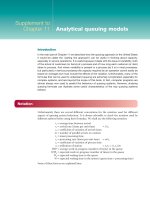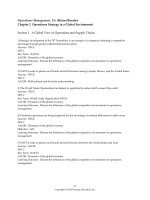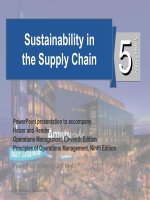Operations management heizer 6e ch07
Bạn đang xem bản rút gọn của tài liệu. Xem và tải ngay bản đầy đủ của tài liệu tại đây (2.2 MB, 63 trang )
Operations
Management
Chapter 7 –
Process Strategy
PowerPoint presentation to accompany
Heizer/Render
Principles of Operations Management, 6e
Operations Management, 8e
© 2006
Prentice
Hall, Inc. Hall, Inc.
©
2006
Prentice
7–1
Outline
Global Company Profile: Dell
Computer Co.
Four Process Strategies
Process Focus
Repetitive Focus
Product Focus
Mass Customization Focus
Comparison of Process Choices
© 2006 Prentice Hall, Inc.
7–2
Outline – Continued
Process Analysis And Design
Flow Diagrams
Time-Function Mapping
Value Stream Mapping
Process Charts
Service Blueprinting
© 2006 Prentice Hall, Inc.
7–3
Outline – Continued
Service Process Design
Customer Interaction and Process
Design
More Opportunities to Improve
Service Processes
Selection Of Equipment And
Technology
© 2006 Prentice Hall, Inc.
7–4
Outline – Continued
Production Technology
Machine Technology
Process Control
Vision Systems
Automated Storage and Retrieval System
Automated Guided Vehicle (AGV)
Flexible Manufacturing System (FMS)
Computer-Integrated Manufacturing
(CIM)
© 2006 Prentice Hall, Inc.
7–5
Outline – Continued
Technology In Services
Process Redesign
Ethics And Environmentally
Friendly Processes
© 2006 Prentice Hall, Inc.
7–6
Learning Objectives
When you complete this chapter, you
should be able to:
Identify or Define:
Process focus
Repetitive focus
Product focus
Process reengineering
Service process issues
Environmental issues
© 2006 Prentice Hall, Inc.
7–7
Learning Objectives
When you complete this chapter, you
should be able to:
Describe or Explain:
Process Analysis
Service Design
Production Technology
Process Redesign
Ethics and Environmentally Friendly
Processes
© 2006 Prentice Hall, Inc.
7–8
Dell Computer Company
“How can we make the process of
buying a computer better?”
Sell custom-built PCs directly to consumer
Build computers rapidly, at low cost, and
only when ordered
Integrate the Web into every aspect of its
business
Focus research on software designed to
make installation and configuration of its
PCs fast and simple
© 2006 Prentice Hall, Inc.
7–9
Process, Volume, and Variety
Volume
Repetitive
Process
Figure 7.1
Low
Volume
High Variety
one or few
units per run,
high variety
(allows
customization)
Changes in
Modules
modest runs,
standardized
modules
Changes in
Attributes
(such as grade,
quality, size,
thickness, etc.)
long runs only
© 2006 Prentice Hall, Inc.
Process Focus
projects, job shops
(machine, print,
carpentry)
Standard Register
High
Volume
Mass Customization
(difficult to achieve,
but huge rewards)
Dell Computer Co.
Repetitive
(autos, motorcycles)
Harley Davidson
Poor Strategy
(Both fixed and
variable costs
are high)
Product Focus
(commercial
baked goods,
steel, glass)
Nucor Steel
7 – 10
Process Flow Diagram
Customer
Purchasing
Customer sales
representative
Vendors
PREPRESS DEPT
Accounting
Receiving
PRINTING DEPT
Warehouse
COLLATING
DEPT
Information flow
Material flow
GLUING, BINDING,
STAPLING, LABELING
POLYWRAP DEPT
SHIPPING
© 2006 Prentice Hall, Inc.
Figure 7.2
7 – 11
Process Strategies
How to produce a product or provide
a service that
Meets or exceeds customer
requirements
Meets cost and managerial goals
Has long term effects on
Efficiency and production flexibility
Costs and quality
© 2006 Prentice Hall, Inc.
7 – 12
Process Strategies
Four basic strategies
Process focus
Repetitive focus
Product focus
Mass customization
Within these basic strategies there are
many ways they may be implemented
© 2006 Prentice Hall, Inc.
7 – 13
Process Focus
Facilities are organized around specific
activities or processes
General purpose equipment and skilled
personnel
High degree of product flexibility
Typically high costs and low equipment
utilization
Product flows may vary considerably
making planning and scheduling a
challenge
© 2006 Prentice Hall, Inc.
7 – 14
Process Focus
Print Shop
Many
inputs
© 2006 Prentice Hall, Inc.
High
variety
of
outputs
7 – 15
Repetitive Focus
Facilities often organized as
assembly lines
Characterized by modules with parts
and assemblies made previously
Modules may be combined for many
output options
Less flexibility than processfocused facilities but more efficient
© 2006 Prentice Hall, Inc.
7 – 16
Repetitive Focus
Automobile Assembly Line
Modules
combined
for many
output
options
Raw
materials
and
module
inputs
Few
modules
© 2006 Prentice Hall, Inc.
7 – 17
Process Flow Diagram
Frame tube
bending
Frame-building
work cells
Frame
machining
Hot-paint
frame painting
THE ASSEMBLY LINE
TESTING
28 tests
Incoming parts
Air cleaners
Oil tank work cell
Fluids and mufflers
Shocks and forks
Fuel tank work cell
Handlebars
Wheel work cell
Fender work cell
Engines and
transmissions
From Milwaukee
on a JIT arrival
schedule
Roller testing
Crating
Figure 7.3
© 2006 Prentice Hall, Inc.
7 – 18
Product Focus
Facilities are organized by product
High volume but low variety of
products
Long, continuous production runs
enable efficient processes
Typically high fixed cost but low
variable cost
Generally less skilled labor
© 2006 Prentice Hall, Inc.
7 – 19
Product Focus
Bottling Plant
Many
inputs
© 2006 Prentice Hall, Inc.
Output
variation
in size,
shape,
and
packaging
7 – 20
Product Focus
D
Continuous caster
Nucor Steel Plant
C
Scrap
steel
A
B
Ladle of molten steel
Continuous cast steel
sheared into 24-ton slabs
Hot tunnel furnace - 300 ft
E
Electric
furnace
F
Hot mill for finishing, cooling, and coiling
H
G
I
© 2006 Prentice Hall, Inc.
7 – 21
Comparison of Processes
Process
Focus
(Low volume,
high variety)
Repetitive
Focus
(Modular)
Product Focus
(High-volume,
low-variety)
Mass
Customization
(High-volume,
high-variety)
Small
quantity, large
variety of
products
Long runs,
standardized
product made
from modules
Large
quantity, small
variety of
products
Large
quantity, large
variety of
products
General
purpose
equipment
Special
equipment
aids in use of
assembly line
Special
purpose
equipment
Rapid
changeover
on flexible
equipment
Table 7.2
© 2006 Prentice Hall, Inc.
7 – 22
Comparison of Processes
Process
Focus
(Low volume,
high variety)
Repetitive
Focus
(Modular)
Product Focus
(High-volume,
low-variety)
Mass
Customization
(High-volume,
high-variety)
Operators are
broadly
skilled
Employees
are modestly
trained
Operators are
less broadly
skilled
Flexible
operators are
trained for the
necessary
customization
Many job
instructions
as each job
changes
Repetition
reduces
training and
changes in job
instructions
Few work
orders and job
instructions
because jobs
standardized
Custom
orders require
many job
instructions
Table 7.2
© 2006 Prentice Hall, Inc.
7 – 23
Comparison of Processes
Process
Focus
(Low volume,
high variety)
Repetitive
Focus
(Modular)
Product Focus
(High-volume,
low-variety)
Mass
Customization
(High-volume,
high-variety)
Raw material
inventories
high
JIT
procurement
techniques
used
Raw material
inventories
are low
Raw material
inventories
are low
Work-inprocess is
high
JIT inventory
techniques
used
Work-inprocess
inventory is
low
Work-inprocess
inventory
driven down
by JIT, lean
production
Table 7.2
© 2006 Prentice Hall, Inc.
7 – 24
Comparison of Processes
Process
Focus
(Low volume,
high variety)
Repetitive
Focus
(Modular)
Product Focus
(High-volume,
low-variety)
Mass
Customization
(High-volume,
high-variety)
Units move
slowly
through the
plant
Movement is
measured in
hours and
days
Swift
movement of
unit through
the facility is
typical
Goods move
swiftly
through the
facility
Finished
goods made
to order
Finished
goods made
to frequent
forecast
Finished
goods made
to forecast
and stored
Finished
goods often
made to order
Table 7.2
© 2006 Prentice Hall, Inc.
7 – 25









